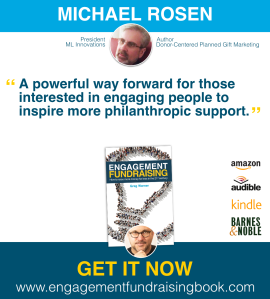Should employees donate to the nonprofit organization they work for? Should they be asked, or even required, to give? Should employees never be asked to give?
Over the decades, I’ve had a number of clients ask me about the issue of employee giving. Over the years, my feelings about employee giving have flip-flopped any number of times. On the one hand, I’ve considered it a good idea to express one’s support for the organization before asking someone else to give. On the other hand, I’ve also recognized that nonprofit employees are frequently paid far less than they should be and often work many uncompensated overtime hours.
It’s a complicated issue.
 Fortunately, there is now a new e-book that closely explores the subject of employee giving. Employee Giving: Does Charity Begin in the Office? is a free e-book by Ephraim Gopin, founder of 1832 Communications, an agency helping nonprofits raise more money through strategic and smart marketing and communications.
Fortunately, there is now a new e-book that closely explores the subject of employee giving. Employee Giving: Does Charity Begin in the Office? is a free e-book by Ephraim Gopin, founder of 1832 Communications, an agency helping nonprofits raise more money through strategic and smart marketing and communications.
As part of the e-book project, Ephraim conducted a survey of nonprofit employees and consultants so he could explore all sides of a very contentious and complicated topic. The result is an e-book that will help you learn about:
- Employee giving: The case for yes, the case for no, and why it’s complicated
- Attitudes about Board and C-level giving
- How employees working overtime affects giving
- Can employee giving help when asking donors to give
- And much more!
Learn from the survey data and over 30 sector experts. Whether you’re in the “oh hell no!” or the “let employees enjoy being a donor!” camp, this e-book will open your eyes to both sides of the issue. Reading the e-book might just change your mind. You can download your free copy by clicking here.
The topic of nonprofit employee giving doesn’t get much attention. So, I was intrigued when I saw Ephraim had written his e-book. Recently, I had the opportunity to ask him a few questions related to the project. Here’s what he had to say:
What workplace ask have you experienced that stuck with you, good or bad?
Here’s how I open my introduction to the e-book: “The honest truth? I never gave. Even when I was a CEO.”
No one ever asked me and I never asked my employees when I was CEO. (It could be cultural as where I live it is definitely not the norm to ask employees to donate.) For me it would have been double-dipping: “I give way more hours to the organization than what’s stipulated in my contract. Now you also want to take a portion of my salary check away?!”
In the survey, I asked how much overtime (unpaid time) employees work in an average month. 41 percent of survey respondents said they work 11+ hours of overtime each month. That’s A LOT!
So, you’re overworked and underpaid, certainly in comparison to the for-profit sector. How would you feel if, now, you also are being asked to donate back to the organization that “steals” your precious few off-hours of family and friends time? There’s a reason why people are very vocal about their opposition to employee-giving programs.
At the same time, the e-book includes a few stories of internal-giving programs done right. No pressure, employees can decide not to give and it won’t be held against them in any way.
As a consultant, I have given back to some of my clients. The truth is that while preparing the e-book, vendor fundraising did come up and I added it as a topic for thought.
However, if I were an employee, would I also be a donor to that organization? Tough one for me to answer.
Why did you decide to write the e-book?
As many things do nowadays, it all started with a tweet. I was curious to hear from my followers whether they donate/d to the nonprofit they work/ed for. My assumption was they did not.
Why would I assume that? Many nonprofit workers are underpaid, overworked and underappreciated. The thought of these employees also being givers — forced or not — never even crossed my mind.
Yet, the responses to my tweet surprised me: Most of the respondents were in fact donors to the charity they worked for! Obviously, it’s a big world out there and there are many nonprofiteers who did not answer my original tweet.
That’s how the ball got rolling. A year after that initial tweet I published a survey that aimed to measure attitudes related to employee giving and numerous issues surrounding it. My goal was to use the survey data as a backdrop to an e-book on the topic.
Post survey, I conducted almost 60 follow-up interviews via phone or video chat. Every single person I spoke to had very concrete opinions about the topic. Should employees be asked to donate? Plenty of NO! and plenty of YES! to go around.
Why write the e-book? It is a complicated topic I was interested in exploring and learning more about. Besides a blog post here and there, no one has really looked into it to understand why employees should or should not be asked. I feel my e-book can bring the discussion to nonprofit leaders who can make wiser and more informed decisions when considering an employee-giving program.
What do you hope to accomplish with the e-book?













